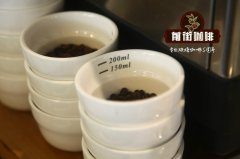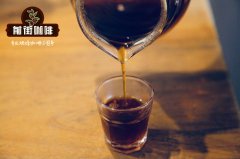The question of the thickness of hand-made coffee powder is how many degrees of gouache and what is the ratio of gouache to water

Professional coffee knowledge exchange more coffee bean information please follow the coffee workshop (Wechat official account cafe_style)
Hand coffee is really good! You can watch the flow of water stay gracefully, while a good coffee is like a crystal-clear liquid, and the best thing is that anyone can make it at home.
But it looks great but it is not as simple as it seems, in addition to the common factors such as water temperature, powder-to-water ratio, grinding thickness and so on, there are also causes of disturbance and agitation. So what is disturbance and agitation? What do experts say about the disturbance and stirring of hand-brewed coffee? And the most important thing is, does it really taste better?
Use Hario V60 to brew, source: Yara Tucek via Flickr, CC BY 2.0
What is agitation?
Let's start with the basics, we all know that there are two procedures in the process of hand brewing: first, soak the coffee powder with a small amount of hot water and wait for about half a minute to achieve the effect of steaming; second, pour the remaining water into the coffee powder so that the coffee can slowly drip into the receiving container.
But there is also agitation or disturbance in the process, just like when you are busy, your brother and sister show up next to you, but it is not so negative, and in fact, you are playing the role of brother and sister.
To put it simply, stirring and disturbing in the cooking process is a mild interference, there are many forms of stirring, each has its own reason, before we see how to stir, let's see what you want to achieve.
Steaming when cooking with Kalita Wave, source: Olgierd Rudak via Flickr, CC BY 2.0
We are all trying to flush out the good taste of the coffee, which means that we need to achieve the same extraction results. If the extraction rates of the powders in different parts of the filter cup are different, you will not be able to manipulate or copy the flavor in the cup. Your coffee will be a mixture of underextracted (sour) and overextracted (bitter) flavors, as well as well-extracted flavors, such as sweetness and good taste.
What can be achieved by stirring?
A common issue in hand-brewed coffee or espresso is the channel effect. Water always flows to places with less resistance, so if the coffee powder is not stacked or soaked evenly, the water will create a channel in the coffee powder. this will make more coffee near the channel extracted.
The channel effect can be caused by too fast or unstable water injection, for example, this leaves a high and dry coffee powder wall on the filter paper, which cannot be extracted. Some people also use drip water injection (using a small amount of water several times instead of long water injection), which can avoid the emergence of such powder walls.
In other words, stirring will disperse the coffee powder and ensure the uniformity of the extraction, which is not the only reason for maintaining a consistent extraction. If you want the coffee to taste the same every day, try standardizing your brewing parameters, including powder quantity, water temperature, brewing filter, water injection path and speed, water quality, grinding thickness and brewing time, etc.
Grind coffee powder to be brewed in Kalita Wave filter cup, source: Olgierd Rudak via Flickr, CC BY 2.0
Extended reading: how to emphasize or reduce the acidity of coffee by brewing?
How to stir hand brewed coffee / drip coffee
There are several ways to stir, the most common of which is stirring, which is recommended by some coffee experts, such as Matt Perger and Scott Rao, a well-known barista. You can stir the coffee powder directly after steaming, or at the beginning of steaming, or in the back section of steaming.
You may also have heard of spoiler, which means that at the end of the injection, pour the water into the edge of the filter cup and flush the top coffee powder into the coffee liquid from the edge.
Agitation can also take several forms, such as drips of water, side swirls, controlling the flow rate and amount of water, and so on.
The force of water injection can stir the coffee powder, source: P å l-Kristian Hamre via Flickr, CC BY 2.0
What techniques do hand coffee experts use?
Matt Perger and Scott Rao mentioned above, let's see what methods they use here. When Matt Perger won the 2012 World Cooking Competition a few years ago, he shared a film about the cooking of V60 filter cups. You can break down his movements, notice that he stirs vigorously after steaming, then control the direction of the hand (the expanding concentric circle), use these forces to avoid the formation of the powder wall, cook rhythmically, and pull up and gently shake the filter cup before the end to make the powder bed horizontal.
He can also be seen in the film using Rao Spin, which takes its name from Scott Rao, which allows the water to rotate in a spiral during cooking, thus allowing the water to drop more evenly.
Even though Rao wasn't the inventor of the technology, it was developed in his work, and he supports it. "it minimizes the channel effect at the end of cooking and creates a flat powder bed at the end of each cooking," Rao said. "it's a great technology. I wish I had invented it."
You can also create a Rao Spin by gently shaking the filter cup, which is shown in the following seven-second video shot by Scott Rao.
Rao is also very supportive of stirring coffee at the end of steaming and brewing, just like Matt Perger.
So how do we apply it?
You can try all of the above, whether you are a barista, a coffee lover or just a beginner, stir while brewing, try not to stir in the next round, and then test the differences yourself. or share it with friends and show it to your guests.
Find out the differences, taste the subtle changes in the coffee, and change the grinding thickness and brewing methods, and then find the best way to copy to keep the brewing results consistent.
The best thing about the third wave of coffee is the experiment, in which you do some stirring experiments to see if this method is suitable for you.
Important Notice :
前街咖啡 FrontStreet Coffee has moved to new addredd:
FrontStreet Coffee Address: 315,Donghua East Road,GuangZhou
Tel:020 38364473
- Prev

How to flush out the flavor of hand-brewed coffee? what if it is very light and has no flavor?
Professional coffee knowledge exchange more coffee bean information please follow the coffee workshop (Wechat official account cafe_style) hand brewed coffee (pour over) can be said to be the most basic and simple way of making fine coffee. There are no complex machines, just hot water, filter and coffee. A cup of fresh coffee can be made in just three minutes. Hand flushing is also a boutique coffee.
- Next

What is the effect of the planting place of Yemeni mocha coffee on coffee flavor? Yemen mocha and coffee trade
Professional coffee knowledge exchange more coffee bean information Please follow the coffee workshop (Wechat official account cafe_style) since 2014, Yemen has been caught in an endless war. Last week, the Geneva-based World Economic Forum released a ranking of the competitiveness of the world's economies, with Yemen at the bottom at 137. The World Economic Forum said Yemen was due to civil war.
Related
- Beginners will see the "Coffee pull flower" guide!
- What is the difference between ice blog purified milk and ordinary milk coffee?
- Why is the Philippines the largest producer of crops in Liberia?
- For coffee extraction, should the fine powder be retained?
- How does extracted espresso fill pressed powder? How much strength does it take to press the powder?
- How to make jasmine cold extract coffee? Is the jasmine + latte good?
- Will this little toy really make the coffee taste better? How does Lily Drip affect coffee extraction?
- Will the action of slapping the filter cup also affect coffee extraction?
- What's the difference between powder-to-water ratio and powder-to-liquid ratio?
- What is the Ethiopian local species? What does it have to do with Heirloom native species?

